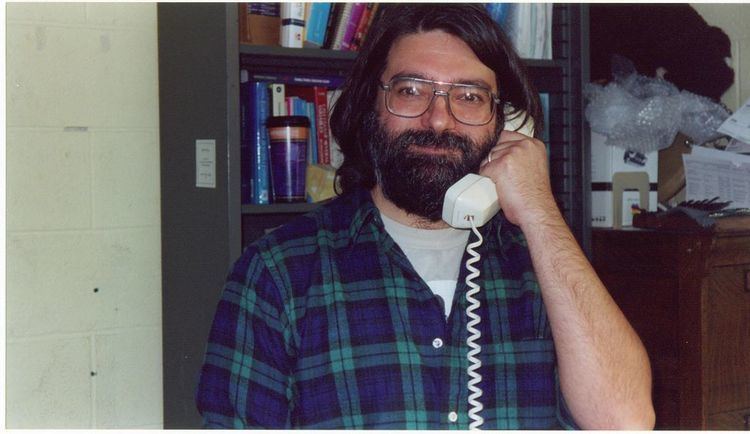Nationality American Name William Sethares | Known for Consonance Alma mater Cornell University | |
 | ||
Born April 19, 1955Massachusetts, USA ( 1955-04-19 ) Books Tuning - timbre - spectrum, Rhythm and Transforms, Software Receiver Design: B, Software Receiver Design: B, Telecommunications Breakdown | ||
Residence United States of America | ||
William sethares topology of musical data
William A. Sethares (born April 19, 1955) is an American music theorist and professor of electrical engineering at the University of Wisconsin. In music, he has contributed to the theory of Dynamic Tonality and provided a formalization of consonance.
Contents
- William sethares topology of musical data
- William sethares at mcm 2017
- Consonance and dissonance
- Dynamic tonality
- Musica Facta
- References
William sethares at mcm 2017
Consonance and dissonance
Among the earliest musical traditions, musical consonance was thought to arise in a quasi-mystical manner from ratios of small whole numbers. (For instance, Pythagoras made observations relating to this, and the ancient Chinese Guqin contains a dotted scale representing the harmonic series.) The source of these ratios, in the pattern of vibrations known as the harmonic series, was exposed by Joseph Sauveur the early 18th century and even more clearly by Helmholtz in the 1860s.
In 1965, Plomp and Levelt showed that this relationship could be generalized beyond the harmonic series, although they did not elaborate in detail.
In the 1990s, Sethares began exploring Plomp and Levelt's generalization, both mathematically and musically. His 1993 paper On the relationship between timbre and scale formalized the relationships between a tuning's notes and a timbre's partials that control sensory consonance. A more accessible version also appeared in Experimental Musical Instruments as "Relating Tuning and Timbre" These papers were followed by two CDs, Xenotonality and Exomusicology (some songs from which can be freely downloaded here), which explored the application of these ideas to musical composition.
In his 1998 book Tuning, Timbre, Spectrum, Scale, Sethares developed these ideas further, using them to expose the intimate relationship between the tunings and timbres of Indonesian and Thai indigienous music, and to explore other novel combinations of related tunings and timbres. Where microtonal music was previously either dissonant (due to being played with harmonic timbres to which it was not "related"), or restricted to the narrow range of harmonically related tunings (to retain sensory consonance), Sethares's mathematical and musical work showed how musicians might explore microtonality without sacrificing sensory consonance.
As one reviewer of the second edition of this book wrote, "Physics had built a prison round music, and Sethares set it free." Another reviewer wrote that it "is not only the most important book about tuning written to date, but it is the most important book about music theory written in human history."
Dynamic tonality
In 2003, Sethares began an informal collaboration with Andrew Milne and Jim Plamondon, whimsically called the Isomorphic Conspiracy. Its aim was to explore the musical relationships exposed by isomorphic keyboards, which are an unusual design of two-dimensional keyboards that have the intriguing characteristic of having transpositional invariance—that is, "the same fingering in every key."
By early 2006, the Isomorphic Conspiracy had discovered that such keyboards also had the same fingering in every tuning, too—or, at least, every tuning of what the Conspiracy came to call the syntonic temperament. This consistency of fingering across tunings, which they called tuning invariance, enables a performer, using an isomorphic keyboard and compatible synthesizer (or software synthesizer), to play a given tonal piece in any of a wide range of tunings. The Conspiracy turned its attention to identifying the means by which different isomorphic keyboards could be compared, and identified the Wicki/Hayden keyboard as being optimal for the syntonic temperament's wide tuning range.
In addition to being able to play in any fixed tuning with consistent fingering, the tuning invariance of isomorphic keyboards enables performers to change a piece's tuning on the fly, along the syntonic temperament's smooth tuning continuum, while retaining consonance (or, optionally, while introducing dissonance to any tonal structure). It soon became clear that this dynamic tonality offered an entirely novel means of controlling tension and release.
To put these ideas into practice, Sethares (with collaborators and students) developed a freely available software-based synthesizer, the TransFormSynth, which enables a performer to bend tunings polyphonically during performance. In April 2008, Sethares used the TransFormSynth to compose and record the first musical piece that used dynamic tonality, which he called "C to Shining C" (although the piece, as recorded, is not actually in any musical key). A single chord is played throughout the piece, yet it gains a feeling of tension and release through its tuning progression from 19-tone equal temperament tuning to 5-tone equal temperament tuning and back, complemented by a slower timbre progression from a fully harmonic timbre to a fully tuning-aligned timbre.
In 2009, Sethares led the Isomorphic Conspiracy's extension of Dynamic tonality to include a wider variety of tunings, including
All of these different tunings can be controlled with identical fingering and full consonance using a dynamic-tonality-capable synthesizer such as the TransFormSynth and an isomorphic keyboard. (The TransFormSynth maps the Wicki/Hayden note-layout to the standard QWERTY keyboard, so that no special keyboard is necessary.)
Musica Facta
Sethares' conception of consonance is one of the foundation-stones of a new research program called Musica Facta.
